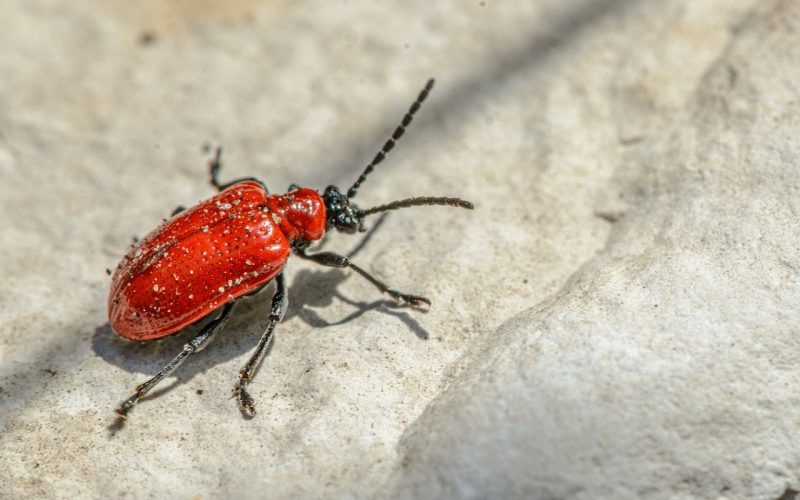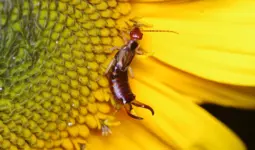The most obvious sign of carpet beetles in and around your house is finding holes in your carpet, clothing, and other furniture.
Even though their name indicates otherwise, carpet beetles are not picky eaters and will devour anything made of fabric, including your clothes, furs, and stuffed animals.
Knowing how to get rid of carpet beetles is the next step if you have bugs in your carpet and think they may be carpet beetles.
What to Know About Carpet Beetles
One of the most destructive insect invaders is carpet beetles. These sinister culprits are less than a quarter of an inch long at the adult stage and are either black or a mix of tan, white, and black.
If you suspect an infestation, investigate the areas around windows and openings where they often gather.
Although annoying, adult carpet beetles aren’t harmful to natural fibers; only their larval stage, when they resemble tiny, hairy worms, poses a risk.
Where They Live
I don’t think these bugs live exclusively in carpets based only on their common name. They may be discovered under baseboards, in pantries, closets, and dressers since, in general, they like dark places.
Additionally, they may find refuge in the cracks and crevices of upholstered furniture like couches and chairs.
Carpet beetles may also be found as dust bunnies beneath furniture and corners, particularly if pet hair or dander is present.
What They Eat
While synthetic fibers are secure, the carpet beetles’ main food sources are more expensive natural fabrics, including garments, blankets, rugs, and carpets made of cotton, linen, silk, and wool.
Unfortunately, the family pantry may also be a food source for these pests since certain carpet beetles eat dry pet food, pasta, wheat, cornmeal, and other grains.
Some varieties of carpet beetles consume potpourri, dried flowers, and even animal skins.
How They Reproduce
A carpet beetle’s life cycle may last from two months to many years.
Adults may lay more than 100 eggs, which hatch in seven to 35 days.
Although carpet beetle larvae can go without food for many weeks, that is the time when the insects are most harmful.
How to Get Rid of Carpet Beetles and Carpet Beetle Larvae
The good news is that carpet beetles may often be eliminated without paying additional fees for an exterminator once you become aware of their existence.
Here are six methods for dealing with harmful larvae and a method for permanently getting rid of adult carpet beetles.
Insecticide
Apply an insecticide to carpet or upholstery containing at least one ingredient: deltamethrin, bifenthrin, or cyfluthrin to stop an active larvae infestation.
Before treating the entire carpet, test the product in a discrete area to ensure it won’t stain.
Many insecticides warn against using them near people or animals, so heed them.
Diatomaceous Earth
Another natural product that swiftly gets rid of carpet beetles by dehydrating larvae is diatomaceous earth, which is sold at agricultural feed shops and by different internet vendors.
Boric acid should be applied to carpets, and some should be sprinkled in pet beds, cupboards, and closets.
Use “food grade” diatomaceous earth, which is safe for both people and animals, but be sure to use it while wearing a respirator or mask to avoid breathing in the tiny dust particles.
Vinegar
White and apple cider vinegar works well to get rid of carpet beetles. Fill an empty spray bottle with pure vinegar and spray it liberally over clothes, carpets, and furniture.
You may want to wash any items kept in a closet or dresser drawers that show evidence of a carpet beetle infestation to get rid of any larvae or eggs that may be present.
Vacuuming and Steam Cleaning
Carpet beetles may be eliminated by routine cleaning, often even before they can do any harm.
Use the proper attachments to clean upholstery and curtains and reach corners.
Steam cleaning your house will destroy larvae and eggs and then suck them up since heat is another effective tool to get rid of carpet beetles.
Fog
Adult female carpet beetles may cause problems by flying about the home, even if they are no longer nibbling on your things.
More importantly, they may lay eggs and begin the unpleasant cycle again if left unattended.
Using a flying insect fogger to get rid of adult carpet beetles. You should also have flying bug spray to eliminate stray insects or newcomers.
Boric Acid
Ingesting or inhaling significant amounts of boric acid, which poisons insect metabolism, is dangerous for people. You may get it in powder form in pharmacies or the supermarket’s laundry section.
It should be evenly sprinkled throughout the carpet before brushing or sweeping into the fibers. Wait several hours before vacuuming thoroughly.
A spoonful of boric acid and two cups of boiling water may also make a spray that kills larvae.
Stir the mixture until the powder is dissolved. Using a plastic spray bottle, spray the solution on the drapes, furniture, baseboards, and other hidden areas.
What Do Carpet Beetles Look Like?
It is important to know that many carpet beetles might bother you when you identify them.
Fortunately, control techniques are typically the same regardless of the type of beetle you’re dealing with because the larvae, not the adult beetles, do the inside damage.
Adult carpet beetles are typically found outside, but because they can fly and are drawn to light, they will also be attracted to your home and the nearby lights.
They will lay their eggs in those locations if they discover them suitable, which might result in a persistent problem.
How to Spot an Infestation
A carpet beetle infestation is simple to ignore until it is too late. Small and difficult to notice, eggs and larvae are particularly common among thick carpet or area rug strands.
Small holes in cushions, upholstery, or an uneven nap in a rug might be your first signs of an infestation.
Many larvae pass through an area if there are more holes or a significantly disturbed region on a carpet.
If there are any indications of damage, examine them more closely.
Look within the carpet’s fibers. Examine the window sills, drapes, and furniture exposed to sunlight daily.
Along with larvae, look for adult beetles and eggs. If you see a few adult beetles, you could have identified the problem before it became an infestation.
It’s time to understand how to get rid of the carpet beetles if you locate them in numerous places around your house or see major damage from the larvae.
How to Prevent Future Infestations?
Once the carpet beetles are gone, take a few preventative measures to prevent them from returning.
Hang sticky flypaper strips near windows to deter adult carpet beetles from entering your house.
Sticky pheromone-type traps may be placed on windowsills and closets to prevent carpet beetles from laying eggs if you often deal with infestations.
Since carpet beetles feed on filthy materials, they remove spills, sweat, and other contaminants from clothes before storage.
Noodles and flour should always be kept in sealed containers. To prevent carpet beetles from settling in your house, maintain a weekly cleaning, sweeping, and vacuuming routine.
Conclusion
When an item that is already infested, such as furniture, a plant, or fur, is brought inside, carpet beetles may enter the house through an open door or window or on that object’s surface.
Carpet beetles are often seen in taxidermy animals as well. Adults may enter houses through open windows and lay eggs on soft surfaces like carpets, rugs, and clothing.
Carpet beetles may quickly establish themselves in a house if the surroundings are not maintained clean and sanitary.
However, follow the above methods to eliminate carpet beetles and be free from these pests.








